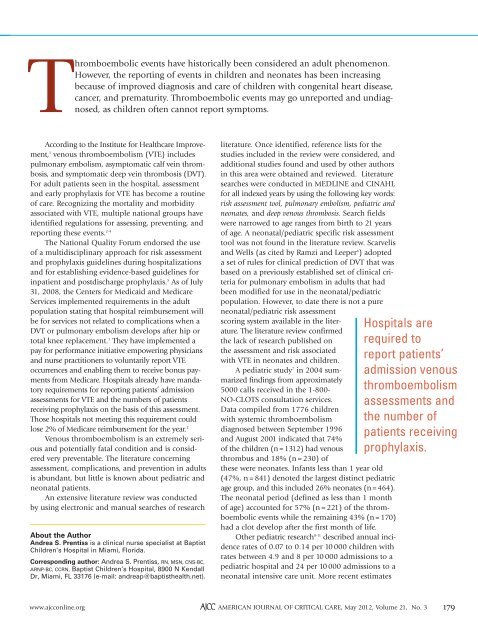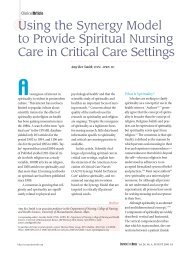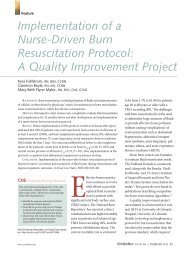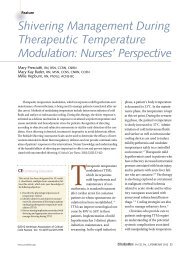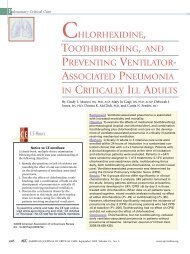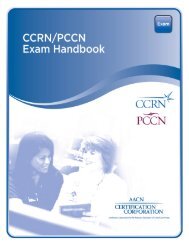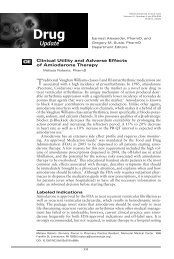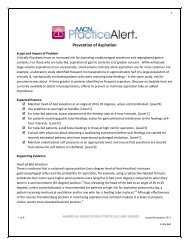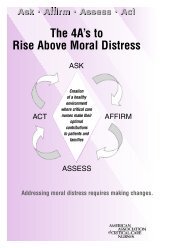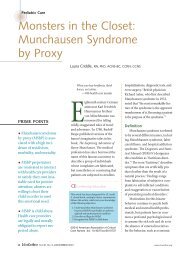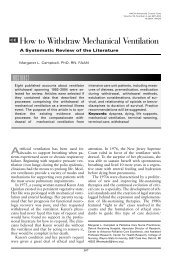Early Recognition of Pediatric Venous Thromboembolism: A Risk ...
Early Recognition of Pediatric Venous Thromboembolism: A Risk ...
Early Recognition of Pediatric Venous Thromboembolism: A Risk ...
Create successful ePaper yourself
Turn your PDF publications into a flip-book with our unique Google optimized e-Paper software.
Thromboembolic events have historically been considered an adult phenomenon.<br />
However, the reporting <strong>of</strong> events in children and neonates has been increasing<br />
because <strong>of</strong> improved diagnosis and care <strong>of</strong> children with congenital heart disease,<br />
cancer, and prematurity. Thromboembolic events may go unreported and undiagnosed,<br />
as children <strong>of</strong>ten cannot report symptoms.<br />
According to the Institute for Healthcare Improvement,<br />
1 venous thromboembolism (VTE) includes<br />
pulmonary embolism, asymptomatic calf vein thrombosis,<br />
and symptomatic deep vein thrombosis (DVT).<br />
For adult patients seen in the hospital, assessment<br />
and early prophylaxis for VTE has become a routine<br />
<strong>of</strong> care. Recognizing the mortality and morbidity<br />
associated with VTE, multiple national groups have<br />
identified regulations for assessing, preventing, and<br />
reporting these events. 2-4<br />
The National Quality Forum endorsed the use<br />
<strong>of</strong> a multidisciplinary approach for risk assessment<br />
and prophylaxis guidelines during hospitalizations<br />
and for establishing evidence-based guidelines for<br />
inpatient and postdischarge prophylaxis. 5 As <strong>of</strong> July<br />
31, 2008, the Centers for Medicaid and Medicare<br />
Services implemented requirements in the adult<br />
population stating that hospital reimbursement will<br />
be for services not related to complications when a<br />
DVT or pulmonary embolism develops after hip or<br />
total knee replacement. 1 They have implemented a<br />
pay for performance initiative empowering physicians<br />
and nurse practitioners to voluntarily report VTE<br />
occurrences and enabling them to receive bonus payments<br />
from Medicare. Hospitals already have mandatory<br />
requirements for reporting patients’ admission<br />
assessments for VTE and the numbers <strong>of</strong> patients<br />
receiving prophylaxis on the basis <strong>of</strong> this assessment.<br />
Those hospitals not meeting this requirement could<br />
lose 2% <strong>of</strong> Medicare reimbursement for the year. 2<br />
<strong>Venous</strong> thromboembolism is an extremely serious<br />
and potentially fatal condition and is considered<br />
very preventable. The literature concerning<br />
assessment, complications, and prevention in adults<br />
is abundant, but little is known about pediatric and<br />
neonatal patients.<br />
An extensive literature review was conducted<br />
by using electronic and manual searches <strong>of</strong> research<br />
About the Author<br />
Andrea S. Prentiss is a clinical nurse specialist at Baptist<br />
Children’s Hospital in Miami, Florida.<br />
Corresponding author: Andrea S. Prentiss, RN, MSN, CNS-BC,<br />
ARNP-BC, CCRN, Baptist Children’s Hospital, 8900 N Kendall<br />
Dr, Miami, FL 33176 (e-mail: andreap@baptisthealth.net).<br />
literature. Once identified, reference lists for the<br />
studies included in the review were considered, and<br />
additional studies found and used by other authors<br />
in this area were obtained and reviewed. Literature<br />
searches were conducted in MEDLINE and CINAHL<br />
for all indexed years by using the following key words:<br />
risk assessment tool, pulmonary embolism, pediatric and<br />
neonates, and deep venous thrombosis. Search fields<br />
were narrowed to age ranges from birth to 21 years<br />
<strong>of</strong> age. A neonatal/pediatric specific risk assessment<br />
tool was not found in the literature review. Scarvelis<br />
and Wells (as cited by Ramzi and Leeper 6 ) adopted<br />
a set <strong>of</strong> rules for clinical prediction <strong>of</strong> DVT that was<br />
based on a previously established set <strong>of</strong> clinical criteria<br />
for pulmonary embolism in adults that had<br />
been modified for use in the neonatal/pediatric<br />
population. However, to date there is not a pure<br />
neonatal/pediatric risk assessment<br />
scoring system available in the literature.<br />
The literature review confirmed<br />
the lack <strong>of</strong> research published on<br />
the assessment and risk associated<br />
with VTE in neonates and children.<br />
A pediatric study 7 in 2004 summarized<br />
findings from approximately<br />
5000 calls received in the 1-800-<br />
NO-CLOTS consultation services.<br />
Data compiled from 1776 children<br />
with systemic thromboembolism<br />
diagnosed between September 1996<br />
and August 2001 indicated that 74%<br />
<strong>of</strong> the children (n = 1312) had venous<br />
thrombus and 18% (n = 230) <strong>of</strong><br />
these were neonates. Infants less than 1 year old<br />
(47%, n = 841) denoted the largest distinct pediatric<br />
age group, and this included 26% neonates (n = 464).<br />
The neonatal period (defined as less than 1 month<br />
<strong>of</strong> age) accounted for 57% (n = 221) <strong>of</strong> the thromboembolic<br />
events while the remaining 43% (n = 170)<br />
had a clot develop after the first month <strong>of</strong> life.<br />
Other pediatric research 8-11 described annual incidence<br />
rates <strong>of</strong> 0.07 to 0.14 per 10 000 children with<br />
rates between 4.9 and 8 per 10 000 admissions to a<br />
pediatric hospital and 24 per 10 000 admissions to a<br />
neonatal intensive care unit. More recent estimates<br />
Hospitals are<br />
required to<br />
report patients’<br />
admission venous<br />
thromboembolism<br />
assessments and<br />
the number <strong>of</strong><br />
patients receiving<br />
prophylaxis.<br />
www.ajcconline.org AJCC AMERICAN JOURNAL OF CRITICAL CARE, May 2012, Volume 21, No. 3 179


